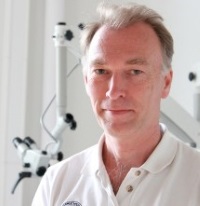
Dr Jesper Hvass Schmidt MD PhD is a Ear-Nose-Throat Specialist who works with the Institute of Clinical Research at the University of Southern Denmark, as well as at the Odense University Hospital, in Denmark – working with the Department of Audiology and Ear-Nose-Throat Head and Neck Surgery. His specialisation is studying the hearing problems of musicians.

Dr Mads Klokker MD is another Ear-Nose-Throat Specialist who works with at the Copenhagen University Hospital in the Department of ENT Head and Neck Surgery & Audiology. He is also a Clinical Associate Professor at the Faculty of Health and Medical Sciences at the Copenhagen University in Denmark. Mads specialises in Ear surgery, ear nerves and balance (otoneurology/vestibulogy) and aviation medicine.
Drs Schmidt and Klokker have conducted a systematic review of the literature on the health effects related to wind turbine noise exposure, and published their work in the peer-reviewed journal PLoS ONE which you can download here – Health Effects Systemic Review.
One aim of the study was to see if the literature disclosed a direct dose-response relationship between noise exposure from wind turbines and the symptoms experienced by neighbours: the “dose-response” being the range and severity of noise induced symptoms at differing distances from turbines.
Drs Schimdt and Klokker pored over the literature – starting with 1,295 papers investigating suspected health-related outcomes associated with wind turbine noise exposure. From this 36 articles addressing specific health related outcomes in relation to wind turbine noise exposure were identified.
The papers were organised into three categories –
- the relationship between annoyance and sound exposure to wind turbines.
- the relationship between exposure to wind turbine noise and sleep disturbance.
- the relationship between exposure to wind turbine noise and psychological distress.
The review looked at the number of people impacted (N), the effects experienced (and other factors relevant to that question) – and importantly, if a dose-response relationship had been detected.
Their conclusions were:
At present it seems reasonable to conclude that noise from wind turbines increases the risk of annoyance and disturbed sleep in exposed subjects in a dose-response relationship.
There seems to be a tolerable limit of around LAeq of 35 dB. Logically, accepting higher limits in legislations may lead to increased numbers of annoyed subjects.
It therefore seems reasonable to conclude that a cautious approach is needed when planning future wind farms. Furthermore, there is an indication that noise annoyance and sleep disturbance are related and that disturbed sleep potentially can lead to adverse health effects.
These conclusions are, however, affected by a potential risk for selection and information bias even in the larger cross-sectional studies providing the current best evidence.
The evidence for adverse health effects other than sleep disturbance is primarily supported by case-series reports which certainly may be affected by various sources of bias.
Larger cross-sectional surveys have so far been unable to document a relationship between various symptoms such as tinnitus, hearing loss, vertigo, headache and exposure to wind turbine noise. One limitation causing this could be that most studies so far have only measured LAeq or Lden.
An additional focus on the measurement of low-frequency sound exposure as well as a more thorough characterisation of the amplitude modulated sound and the relationship between objective and subjective health parameters could lead to different conclusions in the future.
Finally, in regards to the objective measurement of health-related disorders in relation to wind turbine noise, it would be valuable to demonstrate if such health-related outcomes fluctuate depending on exposure to wind turbine noise.
They identified a need for further research – as they were unable to find any study that “examined the potential adverse health effects related to infrasound exposure from wind turbines. Moreover, no studies have specifically examined the relationship between G-weighted sound pressure levels of infrasound with wind turbine noise exposure and health effects, and, likewise, no studies have demonstrated an influence of infrasound on specific vestibular diseases.”
Where Schmidt and Klokker conclude: “that disturbed sleep potentially can lead to adverse health effects”, they might like to take a peek at what the World Heath Organization says on the topic of sleep disturbance and health in its Night-time Noise Guidelines for Europe – the Executive Summary at XI to XII which covers the point – says:
NOISE, SLEEP AND HEALTH
There is plenty of evidence that sleep is a biological necessity, and disturbed sleep is associated with a number of health problems. Studies of sleep disturbance in children and in shift workers clearly show the adverse effects.
Noise disturbs sleep by a number of direct and indirect pathways. Even at very low levels physiological reactions (increase in heart rate, body movements and arousals) can be reliably measured. Also, it was shown that awakening reactions are relatively rare, occurring at a much higher level than the physiological reactions.
The review of available evidence leads to the following conclusions.
- Sleep is a biological necessity and disturbed sleep is associated with a number of adverse impacts on health.
- There is sufficient evidence for biological effects of noise during sleep: increase in heart rate, arousals, sleep stage changes and awakening.
- There is sufficient evidence that night noise exposure causes self-reported sleep disturbance, increase in medicine use, increase in body movements and (environmental) insomnia.
- While noise-induced sleep disturbance is viewed as a health problem in itself (environmental insomnia), it also leads to further consequences for health and well-being.
- There is limited evidence that disturbed sleep causes fatigue, accidents and reduced performance.
- There is limited evidence that noise at night causes hormone level changes and clinical conditions such as cardiovascular illness, depression and other mental illness. It should be stressed that a plausible biological model is available with sufficient evidence for the elements of the causal chain.
STT tends to think the World Health Organization – after more than 60 years of studying the problem – might just know a thing or two about night-time noise, sleep and health. But, then again, common sense rarely needs an advocate.


Mr Dean you are absolutely correct.
Ever since the revelatory research of Kelley/NASA in the 1980’s which produced rigorous scientific peer reviewed evidence of the adverse health impacts of ILFN from industrial windturbines, the industry and its coterie of unethical acousticians have been willingly blind to the acoustic pollution from industrial wind turbines and intentionally misleading with respect to environmental noise protection standards. Governments and senior bureacrats have been complicit, with corruption and deceptive practice the norm rather than exception.
Huge profits were at stake, kickbacks like confetti (Milnes Green’s were easily bought by Vestas, major parties receiving industry largesse, Universities co opted) so bugger the neighbours…
They have tried to hide the science, but their lie is coming undone. Bring on 2015!
It is great that these specialists are getting involved, but I feel the health problems that are known to them from wind turbine sound has been assumed as a loudness problem. There are two areas that I believe have been exploited to deliberately mislead those who have no acoustic training. These are the “A” weighting or sound that is assessed using “G” weighting.
I believe that our problem is a pulsing sound pressure problem and not so much a loudness problem. A loudness problem is normally assessed using a averaging of “A” weighting in the dB scale. A sound pressure problem is assessed without the use of weighting using the dB scale assessed in real time to determine the difference between trough and peak sound pressure that we experience. It must be remembered that it takes approximately one tenth of a second for the blade to pass the tower, and any assessment of peak sound pressure can only be achieved by assessments done in real time.
The use of G weighting is a nonsense from the “Cherry Tree Hearing”. This is because it selects a narrow band of low frequencies and therefore does not include the resultant harmonics coming from the frequencies in the “G” weighting range, or frequencies below this range. This includes consideration of the air pressure waves created from the action of multiple turbines operating in and out of synchrony of each other.
Until the reviews and/or research considers the basics of sound formation assessed in real time in conjunction with the adverse health affects experienced, I feel the unnecessary suffering will largely continue unabated.
Noel Dean